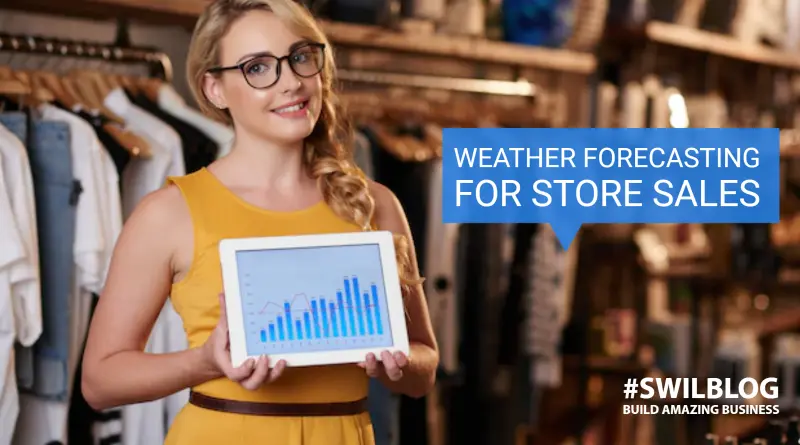The weather may significantly influence purchasing behavior, whether sunny or rainy. A few years back, an unusually mild winter cost retail businesses a considerable amount in missed sales while fuzzy boots, scarves, and snow shovels sat in storefronts gathering dust.
The issue is that merchants did not consider the prediction when planning their merchandise; instead, they continued to base their decisions on the weather and sales patterns from the prior year.
Retailers can stay away from mistakes like this one. You may stop reacting and acting too late and start predicting weather occurrences and being prepared for their effects, thanks to the accessibility of precise atmospheric mapping and accurate weather predictions.
When you have adequate data on your sales, you may also use past retail data to compare weather predictions with and make adjustments to your restocking. Retailers can quickly develop unique marketing, staffing, and merchandising plans for each shop location using hyper-localized weather data, which is now accessible down to the postcode.
Here are 5 strategies merchants may use to reduce waste and enhance decision-making.
1. Select staff members wisely and affordably
Your shop managers can make more efficient work schedule plans by being aware of weather predictions. For instance, you could anticipate that your main street businesses would get more clients on a bright winter day than your mall sites, so you should staff those locations appropriately.
You may need additional staff to keep the business entryway tidy and dry on rainy and snowy days. Ensure you have adequate workers on the product pickup and home delivery teams since there is often a more significant demand for pick-up services when the weather is extremely poor.
If you have experience in the industry, making these hiring choices will come naturally to you. However, only a few store managers have the time on a typical day to examine the weather prediction and determine how many staff are required in each shop depending on the weather.
You may automate and improve your staffing choices by using a staff management system that considers a variety of criteria, including workers’ availability, overtime, and external elements like the weather.
2. Increase marketing
You can order things at the appropriate time by having precise weather prediction data. You may want to start putting out grills, insect repellant, and shorts sooner than usual if the spring is predicted to be unusually warm.
Are changes in temperature anticipated? Make sure you have an adequate cold and flu medication on hand, but hold off on removing the warm socks from the shelf. Looking at your customers’ basket mix in connection to the weather is an excellent method to discover how to improve your merchandising; you could uncover some unexpected links.
For instance, the Weather Company found that ice cream sales rise with the temperature only up to a maximum of 25°C (77°F). Ice cream sales drastically decline whenever it gets warmer than that. Families tended to purchase smaller-sized goods during economic downturns but returned to larger packages amid inclement weather.
Big data enabled the business to acquire the appropriate supply and comprehend unexplained sales changes.
3. Improve the effectiveness of your marketing
Have you ever considered using weather data in your marketing campaigns? Using big data and geo-targeted mobile marketing, you can quickly see a 10% boost in sales in only one year.
A company developed an algorithm that considered various factors, such as weather, travel conditions, and cancellation rates by airport and airline, using publicly accessible weather and flight cancellation information. The business sends targeted mobile advertising to stranded passengers with a link to instantly book a nearby hotel, knowing that most tourists use mobile devices. The work was worthwhile.
You may also take additional measures, like adjusting your store displays, shop window, or homepage to match what your clients are searching for, provided you have researched and know what kinds of things are most prevalent during particular weather conditions.
4. Be prepared for extreme weather conditions
Retailers must be ready for the effects weather will have on their operations as severe weather occurrences spread around the globe. Events like floods, droughts, intense storms, or tornadoes may create all kinds of retail interruptions, resulting in delayed deliveries, staffing issues, and unavailable goods.
However, it goes beyond stocking up on canned foods and flashlights. Technology may assist stores in being ready for such eventualities. For instance, Predictive software may be used with geographic data to reroute supplies, discover substitute suppliers when required, and reduce economic risks brought by harsh weather.
5. Improve the price
Retailers may boost their income by changing prices based on the weather. If you anticipate a heat wave in the first few days of August, you may postpone your end-of-season discount and continue offering the total price on summer merchandise. Not only online but dynamic pricing is also becoming more and more prevalent.
A retail expert predicts that when brick-and-mortar businesses begin experimenting with models based on different aspects, such as weather data, we’ll soon see more dynamic pricing utilized in-store. Certain companies already realize profits from altering pricing for the weather.
A dynamic pricing system at Dublin Airport that automatically determines the best amount to charge for parking spots near the gate depending on the weather and space availability generated a respectable return.
Conclusion
If you let nature take its course, the weather can negatively affect your sales. However, you may expect a successful outcome if you anticipate the hazards. No of the season, planning your strategy around the prediction can provide you with a competitive edge and boost sales.








